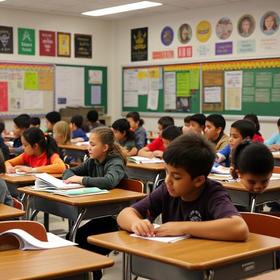Is Student-Based Funding Coming to Georgia Schools?
As schools look at various options to improve school and student performance, one variable consistently comes to the forefront – money. While many educators assert that bigger budgets could solve many of the problems in education today, politicians at all levels agree that more money is probably not needed in the foreseeable future for most school districts across the country. In place of more funding, some areas are now looking at different ways to allocate the money that is currently available. Student-based funding is the new buzzword for school districts interested in getting the money to the schools and students who need it most. Now, Georgia is joining the student-based funding bandwagon.
What is Student-Based Funding?
Student-based funding is a method of allotting funding to school districts and even individual schools based on the needs of individual students. This contrasts with traditional school funding determined by educational programs, creating an average amount spent on every student within a given district. Proponents of student-based funding argue that traditional funding results in disparities throughout the educational system, as schools with high-need students are left wanting resources. Student-based funding aims to reduce those disparities without needing additional money, which educators regularly champion.
This video offers a discussion of student-based funding.
According to the Annenberg Institute for School Reform website, student-based funding begins by assigning specific weights to each type of student. The weights are measured by the cost of educating that student, whether a student with special needs, a gifted student, or an average student. Once those specific weights are determined, funding can be allotted to each district and school based on a precise formula that more accurately takes the particular needs of the student population into consideration.
Transition of Power
The other unique feature of student-based funding is that it takes control of the education process out of the hands of state government and puts it into local school boards and administrators. Currently, states make all the decisions on school funding across the entire state, and any changes that are made to budget allotments must be done on a statewide basis. The Florida Times-Union points out that this system has left educators in areas without sufficient resources to ask for more money on a state level – a request that few, if any, states have been in a position to grant in recent years.
This video offers another look at student-based funding and how it works.
With student-based funding, local officials and school principals are responsible for determining how the money will be spent – whether on higher salaries for some teachers, technology, or student special services. The focus is on the spending structure rather than the money going into the school system. With the additional budgeting privileges come more responsibility, as principals are held accountable for how money is spent and the outcomes.
Benefits of Student-Based Funding
Proponents of student-based funding believe this system allows for more equity throughout the educational system. Students will receive appropriate resources based on their needs rather than simply handing out the same amount to each student based on revenue and population. Student-based funding also allows for more autonomy within the school system, which may lead to more effective solutions to specific student learning needs.
Student-based funding may also lead to greater transparency and accountability within the governing system. Because schools will be responsible for their budgeting systems, it will be easier to track where funding is spent. If appropriate training is provided as well, the potential is there for more efficient, effective spending for each school and student.
Student-based funding is a relatively new concept in the United States, so there is relatively little data to draw from to determine if the system accurately achieves its goals. However, several large cities nationwide have shifted to student-based funding models, including Houston, Baltimore, Los Angeles, Pittsburg, and New York City. In the short time the system has been utilized, educators have found that weights for different types of students vary significantly from location to location. However, these discrepancies may accurately reflect the needs of the students in those areas – time and data will tell.
Georgia’s Exploration of Student-Based Funding
As Georgia weighs in on the idea of student-based funding on a statewide level, it would be the first state to embrace the new model on such a large scale. Atlanta Daily World reports that the recommendation to move to a student-based funding system came from the Georgia Chamber of Commerce. The recommendation comes in the form of a 48-page report that was put together by the chamber in partnership with the Bill and Melinda Gates Foundation and Public Impact, which provided the research for the study.
This video reports on how Arizona's results-based funding program gave low-income district and charter schools $14 million. Middle- and higher-income ones got $24 million.
According to the report, the state of Georgia currently allows more than 90 percent of its education funding based on traditional methods that use academic programs as the guide. The chamber recommends that the state shift the allotment model so that 90 to 95 percent of the funding would be determined according to a student-based funding formula. The report includes a quote by Georgia Governor Nathan Neal, who stated the plan deserves “serious consideration.”
The chamber’s report comes in conjunction with another Georgia report on education funding from a commission appointed by the governor two years ago. The second report recognizes the need to revamp the current method of allotting financing but makes little mention of the student-based funding approach. Both reports will need to be considered by state lawmakers in the future.
Questions? Contact us on Facebook and Instagram. @publicschoolreview
#StudentBasedFunding #GeorgiaEducation #SchoolFinance #EducationEquity #BudgetReform #publicschools















